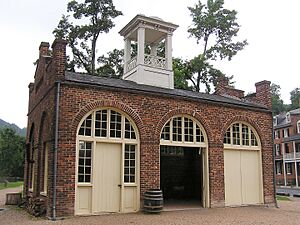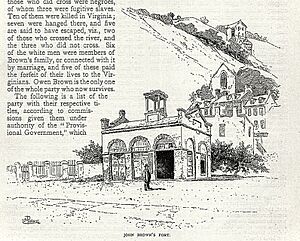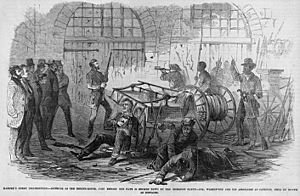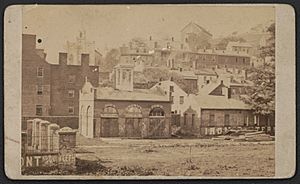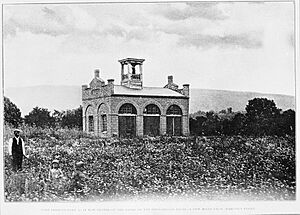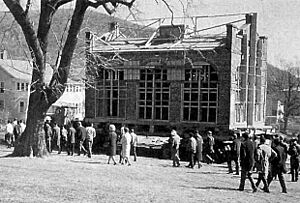John Brown's Fort facts for kids
John Brown's Fort was first built in 1848 in Harpers Ferry, West Virginia. It was a guard house and fire engine house for the federal Harpers Ferry Armory. The building was made of brick, had a slate roof, and copper gutters.
This building became famous because of John Brown. In 1859, he used it as a hiding place during his raid on Harpers Ferry. Brown hoped to start a movement to end slavery. The fort is the only building left from the Armory. Other buildings were destroyed during the Civil War.
After the raid, the building quickly became a popular place for tourists. People even painted "John Brown's Fort" over the doors to attract visitors. The fort has been moved four times! It traveled to Chicago in 1891, then to a farm near Harpers Ferry in 1895. In 1909, it moved to the campus of Storer College in Harpers Ferry. Finally, in 1968, the National Park Service moved it to its current spot. This spot is close to where it first stood. A tall stone monument, called an obelisk, now marks the fort's original location. Today, the fort, the obelisk, and the Storer College campus are all part of the Harpers Ferry National Historical Park.
You can even see the fort on West Virginia's America the Beautiful quarter!
Contents
John Brown's Raid on Harpers Ferry
John Brown planned to take over the armory and its weapons. He wanted to use these weapons to arm a group of people who wanted to end slavery. These groups included abolitionists and formerly enslaved people.
On the night of October 16, 1859, Brown and his small group of 21 men began their raid. They captured the armory and took 60 citizens of Harpers Ferry as hostages. Local townspeople and militia fought back, and some of Brown's men were killed. Brown and his remaining men were forced to hide in the strong fire engine house. They held several hostages inside and prepared to defend themselves.
On the night of October 17, U.S. Marines arrived in Harpers Ferry. They were led by Brevet Colonel Robert E. Lee and his aide J.E.B. Stuart. They came to stop Brown's raid. The next morning, the Marines used a ladder like a battering ram to break down the engine house door. They stormed inside. One Marine and several of Brown's men were badly wounded or killed. Some of Brown's men escaped, but most were captured, including Brown himself. The hostages were set free.
After the Raid: A Famous Landmark
The engine house was the only building from the Harper's Ferry Armory that survived the Civil War. Harpers Ferry saw a lot of fighting and changed hands many times during the war.
To attract visitors, especially Black tourists, the words "John Brown's Fort" were painted on the building. It became a very important place for African Americans in the late 1800s. However, by 1882, the fort was in bad shape. Its roof and windows were gone.
Many bricks from the fort were taken or sold as souvenirs. For example, Frederick Douglass had one at his home. Some white townspeople were not happy about the fort being in their town. They saw Brown as a madman, not a hero, and disliked the Black tourists it attracted.
The Fort's Four Journeys

First Move: To Chicago
The Baltimore and Ohio Railroad bought the fort and its land. They wanted to move their train tracks to a safer spot away from floods. In 1891, the fort was sold for $1,000. The buyer wanted to show it at the World's Columbian Exposition in Chicago. But this idea didn't work out because people didn't connect the fort with Chicago. After the exhibition, the building was taken apart and left in an empty lot.
In 1894, a journalist named Kate Field started a movement to bring the fort back to Harpers Ferry. It couldn't go back to its exact original spot. The railroad had built an embankment over it, raising the tracks to prevent flooding. So, in 1895, the original spot was marked with a white stone obelisk. This monument stands about 150 feet from where the fort is today. It is also part of Harpers Ferry National Historic Park.
Second Move: Back to Harpers Ferry Area
The Baltimore and Ohio Railroad offered to ship the fort back to Harpers Ferry for free. They had lost passengers when the fort moved to Chicago. Alexander and Mary Murphy offered 5 acres of their farm, about 2 miles from Harpers Ferry, for the fort's new home. Many people helped raise money to rebuild it, including William McKinley, who was Governor of Ohio at the time. The fort was rebuilt on the Murphy farm by November 1895. About 8,000 new bricks were needed to replace the ones that had been lost. While on the farm, the fort was used to store wheat.
The Murphy farm is now part of the Harpers Ferry National Historical Park. Moving the fort back to Harpers Ferry brought many African-American visitors, just as the railroad had hoped. The first national meeting of the National League of Colored Women even visited the fort.
Visitors reached a high point in 1906. The Niagara Movement, a group that helped start the NAACP, held its first American meeting at Storer College in Harpers Ferry. They held a special "John Brown Day" on August 17. Over a hundred important African-American men and women walked from Storer College to the fort. Among them were W.E.B. DuBois and Lewis Douglas. The leader of the walk, a doctor named Owen Waller, even walked barefoot. He felt like he was walking on holy ground.
Third Move: To Storer College
Because the farm location was hard to reach, the fort was moved again in 1909. This was its third move, and it went to Storer College. It stayed there until 1969, which is longer than it has been at any other spot since 1859. The college bought the fort from Alexander Murphy for $900. Murphy wanted money because so many tourists had damaged his crops.
When the fort was rebuilt at Storer College, it was accidentally put together backward! The builders were using a photo that was a reversed image. While at the college, the fort became a museum. It held old guns, helmets, money, and other interesting items. Students at the college gave tours of the fort. They were very proud of it, and it was a symbol of freedom for them. Giving tours also helped students practice public speaking.
In 1918, former students of Storer College paid for a plaque to be placed on the fort's west wall. The plaque honors John Brown and his men. It says they gave their lives so that the nation could have "a new birth of freedom" and to remove slavery forever.
Fourth Move: To the National Park Service
When the Harpers Ferry National Monument was created, it did not include John Brown's Fort. The local Black community did not want the fort moved away from Storer College. They felt the Park Service was trying to lessen the importance of the raid for African Americans.
In 1960, the National Park Service acquired the building. It remained the main tourist attraction in Harpers Ferry. Many visitors came to see it at the college. This made it hard for the Park Service to carry out its plans for the former college grounds. The Park Superintendent wanted to reduce the large number of visitors and cars in that area.
To do this, the Park Service moved the fort one more time in 1968. This was its fourth move. Since the original location was covered by a railroad embankment, it was moved to a spot close by. This new spot is the most central location in Harpers Ferry. The fort is now part of the Harpers Ferry National Historical Park. It sits about 150 feet east of its original location. It is the most visited tourist attraction in West Virginia.
The fort was placed in Arsenal Square to help manage crowds and discourage parking in lower Harpers Ferry. Visitors now use satellite parking and shuttle buses.
The fort is not exactly like it was originally. It has been taken apart, moved, and rebuilt many times. The doors are not the original ones, and the building was painted grey when it was part of the Armory. As mentioned, 8,000 bricks replaced the original ones taken as souvenirs. Also, parts of the building were "rebuilt backward" because of a reversed photo used as a guide. In 2005, it was described as "a bit smaller than its original size."
A publication from the Harpers Ferry Historical Association says that the original armory gate is now in the John Brown Museum. This gate had been taken by Alexander Murphy and used at his coal yard. It was given to the National Park Service in 1991.
Replica at Discovery Park of America
In 2012, a copy of the firehouse was built at the Discovery Park of America museum park in Union City, Tennessee. There is a sign there that explains its connection to John Brown's raid.
See also


